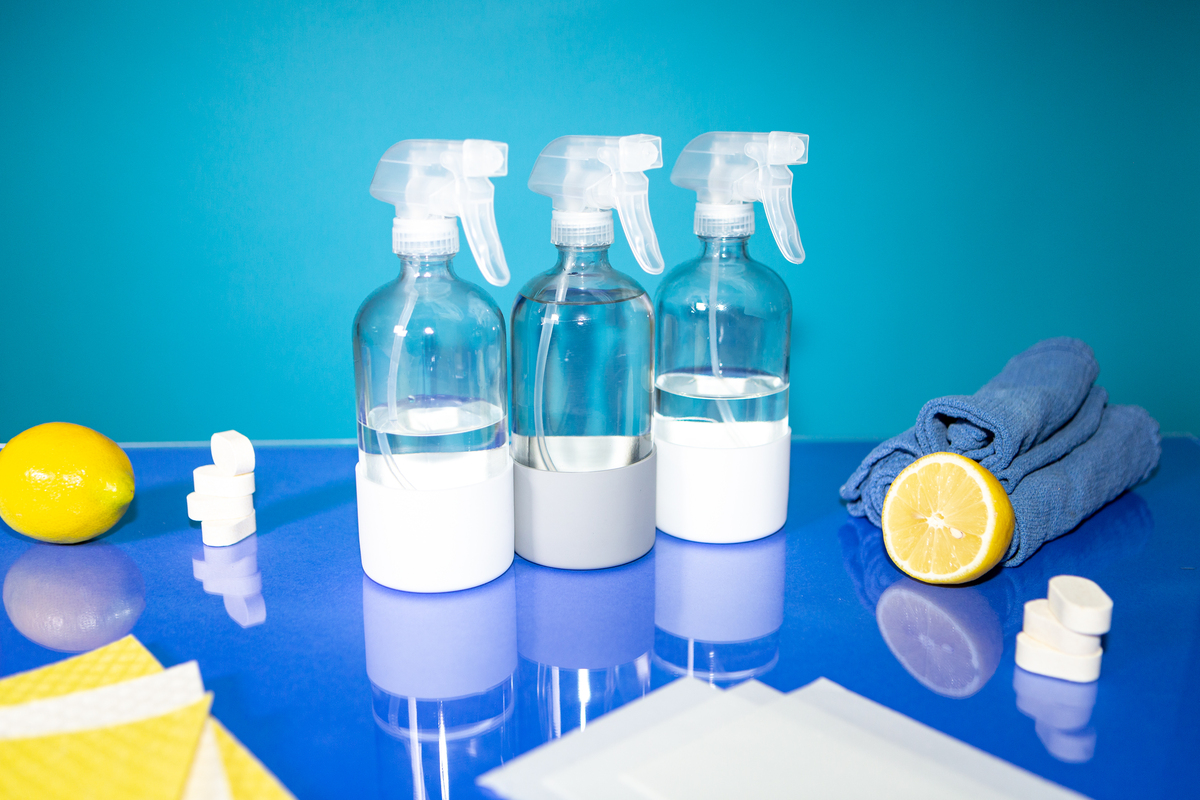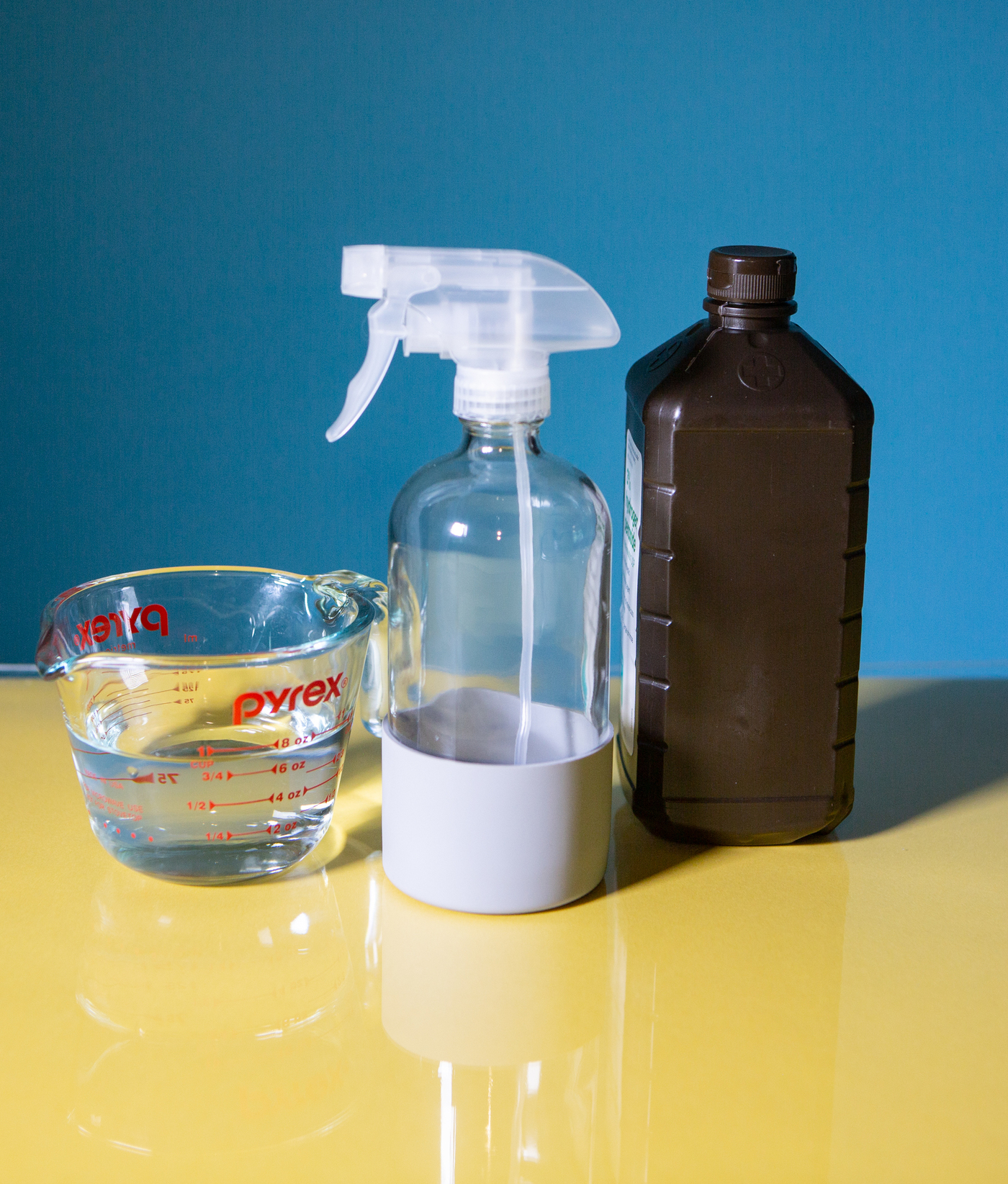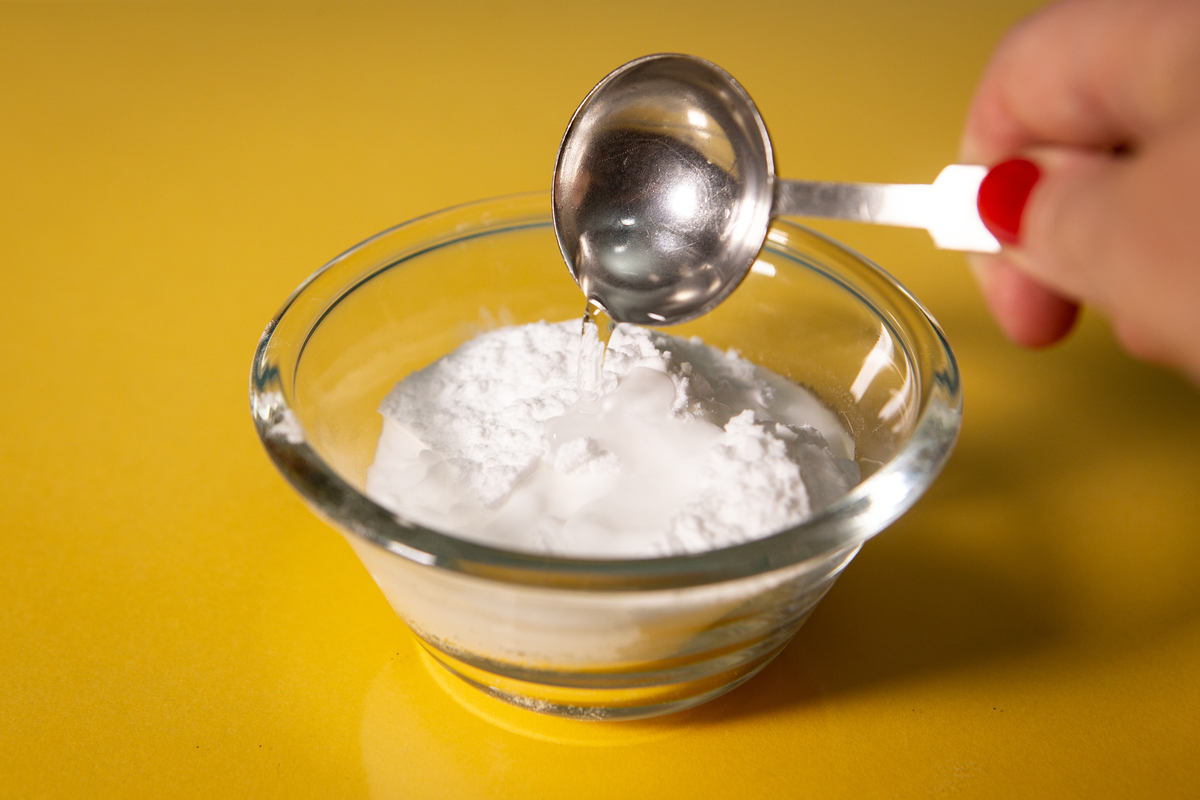Swapping out some basic supplies can help you explore eco-friendly cleaning. Swedish dish towels, reusable cloths, detergent sheets, hand soap tablets and glass bottles for mixing your own solutions are good building blocks for a green cleaning routine.
Photo Illustration by Becky Harlan/NPR
hide caption
toggle caption
Photo Illustration by Becky Harlan/NPR
Swapping out some basic supplies can help you explore eco-friendly cleaning. Swedish dish towels, reusable cloths, detergent sheets, hand soap tablets and glass bottles for mixing your own solutions are good building blocks for a green cleaning routine.
Photo Illustration by Becky Harlan/NPR
Cleaning is a fundamental part of life. We have to clean ourselves, our clothes, our dishes, our homes – and for each of these tasks, there are countless products filled with ingredients with names so long and complicated, we have no idea what they are.
“There has to be a better way to clean our homes and not have to worry about what we are spraying [all over our homes],” says Stephanie Moram, who runs the website Good Girl Gone Green and hosts the podcast Green Junkie.
When she first started thinking about environmentally-friendly cleaning and living, Moram was just curious about the products she was using, and their impact on her family’s health and the environment. Now, she makes her own cleaning products, practices zero-waste living and researches brands to make sure they’re both sustainable and ethical before making a purchase.
Practicing green cleaning isn’t zero-sum, says Moram. “You don’t have to throw out everything in your house to live sustainably,” she says.

Think of your journey to sustainable living as being on a spectrum of greens. “No matter where you fall, if it’s mint green or dark green or lime green or really dark forest green, it doesn’t matter,” she says. “We’re all just moving forward together and doing the best we can.”
If you’re interested in more sustainable cleaning, here are some tips to get you started:
Invest in items you can reuse

Swedish dish cloths, reusable cloths or cut up t-shirts all make good substitutes for paper towels.
Photo Illustration by Becky Harlan/NPR
hide caption
toggle caption
Photo Illustration by Becky Harlan/NPR
Swedish dish cloths, reusable cloths or cut up t-shirts all make good substitutes for paper towels.
Photo Illustration by Becky Harlan/NPR
Replace paper towels and sponges with old t-shirts and Swedish dishcloths.
“Swedish dishcloths are super…absorbent and you can keep reusing them,” says Moram. They’re spongy towels made from cellulose and cotton, which means they can be washed and reused, and when you’re ready to throw them out, they’ll eventually decompose.
Look for ways to cut back on packaging for products you buy

The detergent bottle on the left performs 45 washes per bottle, the stack of detergent sheets performs 60.
Photo Illustration by Becky Harlan/NPR
hide caption
toggle caption
Photo Illustration by Becky Harlan/NPR
The detergent bottle on the left performs 45 washes per bottle, the stack of detergent sheets performs 60.
Photo Illustration by Becky Harlan/NPR
Next time you’re ready to buy laundry detergent, think about how it’s packaged. Liquid detergent usually comes in a plastic container and it can be pretty heavy. “That has an environmental impact,” says Moram, from how much space it takes up in a shipping container to how much water is used in the liquid detergent itself.
Instead, Moram uses laundry strips, which look like strips of paper packed with concentrated cleaning agents which dissolve in the wash cycle. “It comes pretty much in an envelope … and all I do is rip off a strip and I put it in the washing machine,” she explains. “Overall, it’s less expensive, it’s less packaging and … you’ll be able to transport more of that to people versus one big jug of laundry detergent.”
You can buy other cleaning products like hand washing soap and surface or mirror cleaners in tablet form. Just mix them with water at home in a reusable bottle.
If you already have big bottles of detergent, you can refill them at refill stores instead of buying fresh bottles. While you’re there, you can also refill shampoo, soap and other cleaning products.
Read labels – and don’t fall for buzz words

Photo Illustration by Becky Harlan/NPR
Photo Illustration by Becky Harlan/NPR
When companies label their products with vague terms like “eco-friendly” or “non-toxic,” it doesn’t mean much.
Companies will often advertise certain ingredients that aren’t in their products, without providing more information. “They might replace it with something that’s equally as bad, but it’s not an ingredient that people look for,” Moram explains.
Instead, Moram suggests focusing on reading ingredient labels to see what products do contain. Anything with “fragrance” on its ingredient list is best to avoid: “Companies are not required to disclose what the actual makeup of that fragrance is, and a lot of fragrances are mostly chemicals or not plant-derived unless you’re using some sort of essential oil in there,” she says.
The Environmental Protection Agency (EPA) has this resource to identify cleaning products that are actually environmentally friendly.
Moram will often look up unfamiliar ingredients with the Environmental Working Group, an advocacy organization that specializes in researching toxins and pollutants and advocating for corporate accountability.
Make your own simple-formula cleaning products
If you’re ready to go from mint green to avocado or even forest green on the color spectrum of green living, you can make your own cleaning products using a few simple recipes. DIY products can save you a lot of money, and by making your own cleaners at home, you’re eliminating the environmental impact of packaging and transportation.
ALL-PURPOSE CLEANER FOR FLOORS AND SURFACES
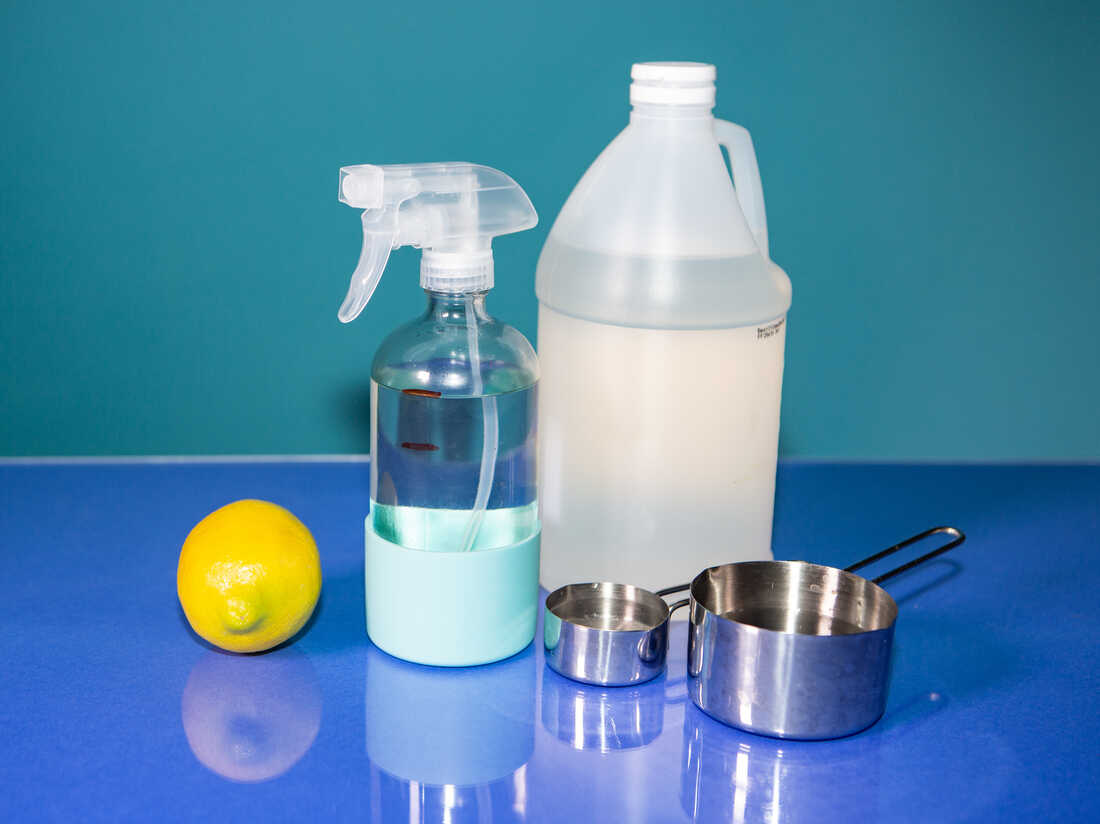
This all-purpose cleaner is made by combining 3/4 water and 1/4 white vinegar.
Photo Illustration by Becky Harlan/NPR
hide caption
toggle caption
Photo Illustration by Becky Harlan/NPR
This all-purpose cleaner is made by combining 3/4 water and 1/4 white vinegar.
Photo Illustration by Becky Harlan/NPR
Supplies:
- ¼ cup of vinegar
- About ¾ cups of water
- Spray bottle
- Essential oil, optional
Directions: Mix water and vinegar in a spray bottle, and use that to spray your floors before wiping with a mop or rag.
If you’re not a fan of the sour smell vinegar can have, Moram suggests adding a few drops of essential oils, like citrus, lavender or pine, or you can open your windows for a little while until the smell dissipates.
HYDROGEN PEROXIDE DISINFECTANT
For a stronger disinfectant for your bathroom or kitchen, Moram suggests a diluted hydrogen peroxide mix.
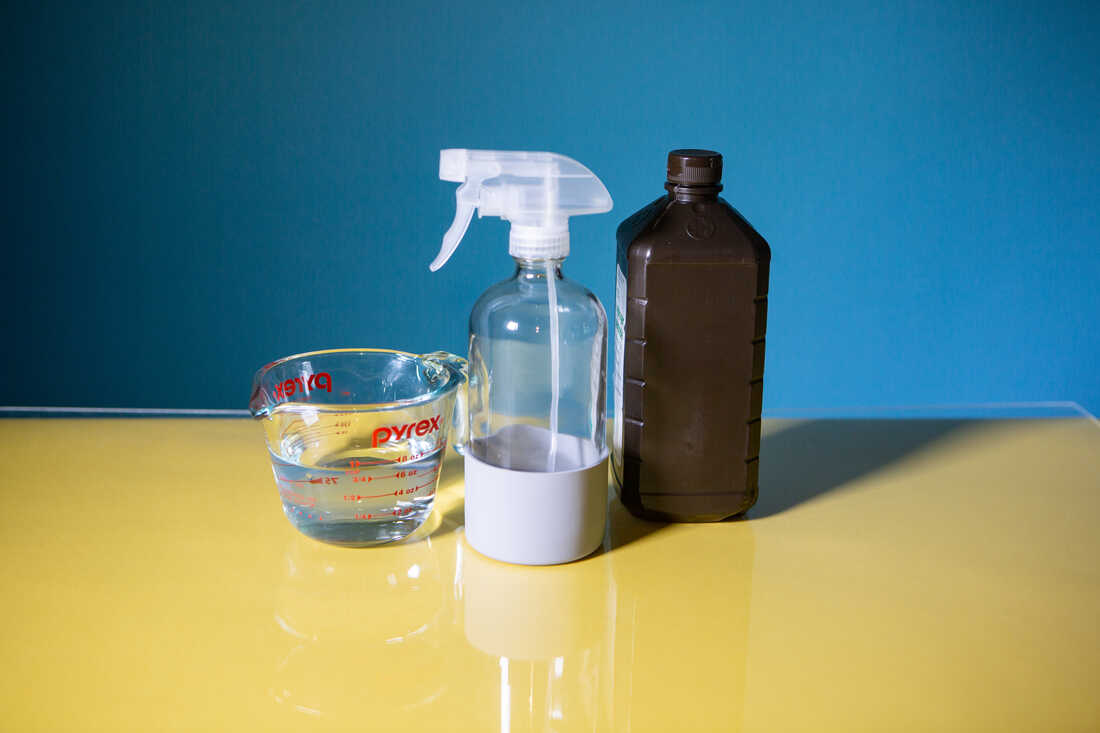
Mix equal parts hydrogen peroxide and water for this disinfectant.
Photo Illustration by Becky Harlan/NPR
hide caption
toggle caption
Photo Illustration by Becky Harlan/NPR
Mix equal parts hydrogen peroxide and water for this disinfectant.
Photo Illustration by Becky Harlan/NPR
Supplies:
- 1/2 cup hydrogen peroxide*
- 1/2 cup water
- Spray bottle
Directions: Mix together and use to disinfect.
(You can find other formulas that suggest a mixture that includes lemon juice.)
Unlike with a vinegar solution, which you can wipe immediately, “with peroxide, you need to let it sit for a few minutes,” Moram says. For example, if you want to disinfect your toilet seat or bathroom counters, you can spray your hydrogen peroxide solution onto the surfaces you want to treat, go clean another area of your home, and then come back to wipe down your bathroom.
*Be sure to use gloves if you’re cleaning with hydrogen peroxide.
Whatever you do, make sure you do not mix hydrogen peroxide with vinegar in the same bottle. That makes a potentially toxic acid that can be harmful to your health.
THE MANY USES OF BAKING SODA
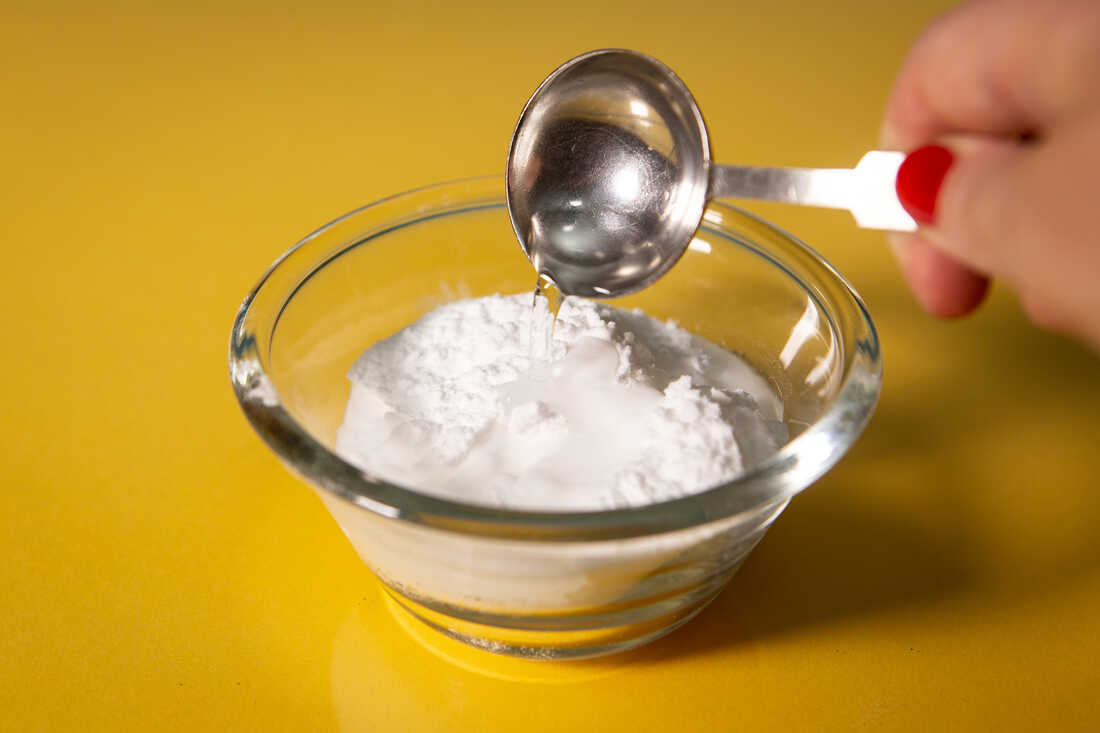
You can make a baking soda paste by adding water to baking soda until the mixture is spreadable.
Photo Illustration by Becky Harlan/NPR
hide caption
toggle caption
Photo Illustration by Becky Harlan/NPR
You can make a baking soda paste by adding water to baking soda until the mixture is spreadable.
Photo Illustration by Becky Harlan/NPR
A paste of baking soda and water makes a good scrub for your sink or bathtub. Or you can unclog your sink by sprinkling some baking soda down the drain, adding vinegar and letting it sit for 15 minutes. Wash it all down with hot water and your drain should be back in business.
The podcast portion of this story was produced by Andee Tagle, with engineering support from Patrick Murray.
We’d love to hear from you. If you have a good life hack, leave us a voicemail at 202-216-9823 or email us at [email protected]. Your tip could appear in an upcoming episode.
Listen to Life Kit on Apple Podcasts and Spotify, or sign up for our newsletter.
[ad_2]
Originally Appeared Here
